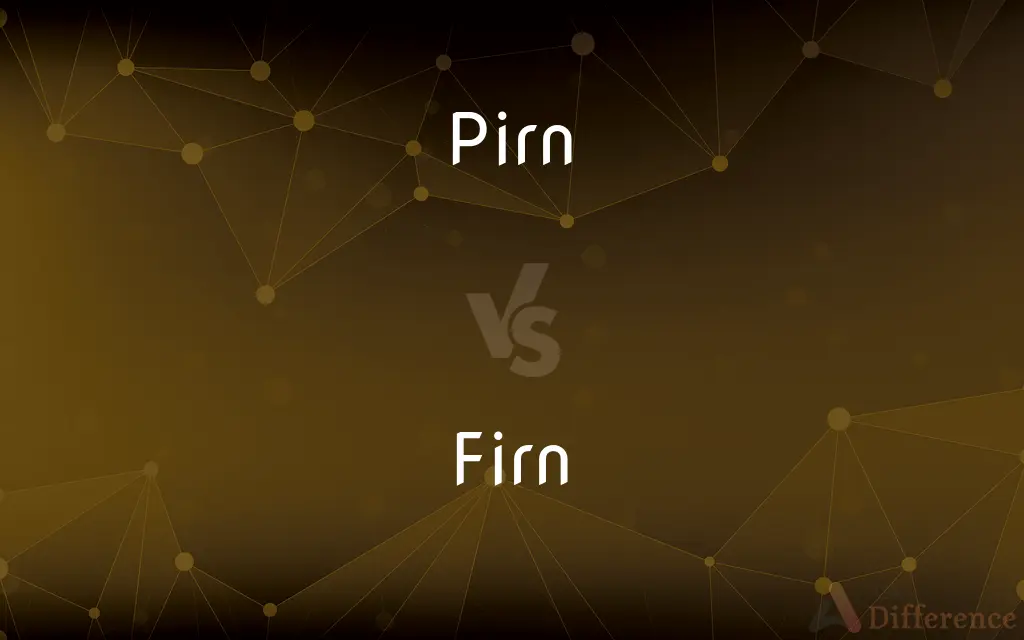Pirn vs. Firn — What's the Difference?
Edited by Tayyaba Rehman — By Urooj Arif — Updated on April 2, 2024
Pirn refers to a weaver's bobbin or spool, while firn is aged snow that has compacted into a denser form but is not yet glacier ice.

Difference Between Pirn and Firn
Table of Contents
ADVERTISEMENT
Key Differences
Pirn is a term used in weaving, referring to a bobbin or spool onto which yarn or thread is wound for use in weaving. On the other hand, firn describes a stage in the transformation of snow into glacier ice. It is old snow that has survived at least one summer melt season, becoming denser and more compact over time. Firn is a critical component in glaciology, representing an intermediate stage between fresh snow and solid ice within glaciers and ice caps.
While pirns are critical to the mechanical process of weaving, enabling the creation of textiles, firn plays a vital role in the natural process of glacier formation. The compacting of firn over time under its own weight leads to the eventual formation of glacier ice, which significantly impacts global climate systems and water cycles. Thus, pirns are integral to human industrial activities, whereas firn is a key element in Earth's cryospheric systems.
The manufacturing and use of pirns involve precision engineering to ensure they are compatible with specific looms and weaving practices. The design of a pirn can affect the tension and delivery of yarn during weaving, impacting the quality of the final fabric. Conversely, the formation of firn involves natural processes of compaction and recrystallization under cold temperatures, requiring years to transition fully into glacier ice. The study of firn and its properties helps scientists understand the dynamics of glaciers and predict changes in response to global warming.
Understanding the difference between pirn and firn underscores the diverse ways in which similar-sounding terms can refer to entirely distinct concepts—one rooted in human technology and craft, and the other in natural geological processes. While pirns contribute to the creation of woven materials that are part of our daily lives, firn is part of the slow, powerful forces that shape our planet's landscape and climate.
Comparison Chart
Definition
A weaver's bobbin or spool for yarn in the textile industry.
Aged snow that has compacted into a denser form but not yet glacier ice.
ADVERTISEMENT
Usage
Used in weaving to hold thread or yarn.
Found in glaciated regions as part of the glacier formation process.
Significance
Essential for the mechanical process of weaving textiles.
Indicates an intermediate stage in the transformation from snow to glacier ice.
Process
Involves winding yarn or thread for use in looms.
Involves natural compaction and recrystallization of snow over time.
Impact
Critical to the production of fabrics and textiles.
Plays a role in glacier dynamics and global climate systems.
Compare with Definitions
Pirn
Widely used in the textile industry for various weaving applications.
Industrial looms may use thousands of pirns in producing large fabric rolls.
Firn
Describes compacted snow on its way to becoming glacier ice.
The firn layer is several meters thick, indicating years of snow accumulation.
Pirn
Must be compatible with specific loom types.
Each type of weaving loom requires a specific pirn design.
Firn
Results from the aging and compression of snow.
Firn forms as accumulated snow survives summer melts and compacts.
Pirn
A bobbin used in weaving to hold yarn or thread.
The weaver loaded the pirn into the shuttle before starting the loom.
Firn
Studied to understand cryospheric dynamics.
Researchers drill cores in firn to study past climate conditions.
Pirn
The design affects the quality of the weave.
Precision-engineered pirns ensure uniform fabric texture.
Firn
Represents a stage between snow and ice in glacier formation.
Firn undergoes further compaction before turning into solid glacier ice.
Pirn
Integral to fabric production, designed for efficient thread delivery.
Modern pirns are designed to minimize tension issues during weaving.
Firn
Helps scientists study glacier health and climate change.
Firn density measurements can indicate changes in precipitation patterns.
Pirn
A Pirn is a rod onto which weft thread is wound for use in weaving. Unlike a bobbin, it is fixed in place, and the thread is delivered off the end of the pirn rather than from the centre.
Firn
Firn (; from Swiss German firn "last year's", cognate with before) is partially compacted névé, a type of snow that has been left over from past seasons and has been recrystallized into a substance denser than névé. It is ice that is at an intermediate stage between snow and glacial ice.
Pirn
A cone-shaped spool or bobbin on which thread or yarn is wound, used most often for weaving.
Firn
Granular, partially consolidated snow that has passed through one summer melt season but is not yet glacial ice. Also called old snow.
Pirn
The amount of thread wound on a shuttle or reel.
Firn
A type of old snow which has gone through multiple thaw and refreeze cycles and thus is made of numerous small icy grains, though it is not nearly as saturated with water as snowcone slush is; can be hard or somewhat soft depending on recent and current weather conditions.
Pirn
(transitive) To wind (yarn) onto a pirn, usually by means of a pirn winder.
Pirn
A quill or reed on which thread or yarn is wound; a bobbin; also, the wound yarn on a weaver's shuttle; also, the reel of a fishing rod.
Common Curiosities
Why is firn important for studying climate change?
Firn layers provide insights into historical climate conditions and glacier dynamics, which are crucial for understanding climate change impacts.
How does firn contribute to glacier formation?
Firn contributes by undergoing compaction and recrystallization, eventually transforming into glacier ice.
Can the quality of a pirn affect textile production?
Yes, the design and quality of a pirn can significantly impact the tension of yarn and the quality of the woven fabric.
What industries rely on pirns?
The textile and fashion industries rely heavily on pirns for the production of woven fabrics.
How do scientists study firn?
Scientists study firn by drilling ice cores, analyzing its density, and measuring compaction rates to understand glacier and climate dynamics.
Can firn be found in all glaciated areas?
Yes, firn is a common component of glaciers and ice caps worldwide, representing a key stage in glacier ice formation.
How long does it take for snow to become firn?
It can take a year or more for snow to transition into firn, depending on environmental conditions.
What is the primary use of a pirn in weaving?
A pirn is used to hold thread or yarn in a loom for the weaving process.
Is there a specific type of snow that becomes firn?
Any snow can become firn if it survives the summer melt season and undergoes compaction over time.
What factors affect the formation of firn?
Temperature, snowfall patterns, and the survival of snow through summer seasons are critical factors in firn formation.
Share Your Discovery

Previous Comparison
Peninsula vs. Peninsular
Next Comparison
Vertical vs. UprightAuthor Spotlight
Written by
Urooj ArifUrooj is a skilled content writer at Ask Difference, known for her exceptional ability to simplify complex topics into engaging and informative content. With a passion for research and a flair for clear, concise writing, she consistently delivers articles that resonate with our diverse audience.
Edited by
Tayyaba RehmanTayyaba Rehman is a distinguished writer, currently serving as a primary contributor to askdifference.com. As a researcher in semantics and etymology, Tayyaba's passion for the complexity of languages and their distinctions has found a perfect home on the platform. Tayyaba delves into the intricacies of language, distinguishing between commonly confused words and phrases, thereby providing clarity for readers worldwide.














































